 Weird Stuff
Weird Stuff  Weird Stuff
Weird Stuff  Mysteries
Mysteries 10 Tragic Disappearances and Deaths in Joshua Tree National Park
 History
History 10 Ways Childhood Really Sucked in the Old West
 Music
Music 10 Name Origins of Famous Bands from the 1990s
 Religion
Religion 10 Biggest Turnarounds by the Catholic Church
 Weird Stuff
Weird Stuff 10 Unbelievable Times Laws Had Unintended Consequences
 Humans
Humans Ten Historic Women Who Deserve Way More Credit Than They Got
 Movies and TV
Movies and TV 10 Films That Spawned Major Lawsuits
 History
History Ten Times Towns Were Wiped Off the Face of the Earth
 Creepy
Creepy 10 of the Most Disturbingly Haunted Public Houses in the UK
 Weird Stuff
Weird Stuff 10 Niche Subcultures That Are More Popular Than You Might Think
 Mysteries
Mysteries 10 Tragic Disappearances and Deaths in Joshua Tree National Park
 History
History 10 Ways Childhood Really Sucked in the Old West
Who's Behind Listverse?

Jamie Frater
Head Editor
Jamie founded Listverse due to an insatiable desire to share fascinating, obscure, and bizarre facts. He has been a guest speaker on numerous national radio and television stations and is a five time published author.
More About Us Music
Music 10 Name Origins of Famous Bands from the 1990s
 Religion
Religion 10 Biggest Turnarounds by the Catholic Church
 Weird Stuff
Weird Stuff 10 Unbelievable Times Laws Had Unintended Consequences
 Humans
Humans Ten Historic Women Who Deserve Way More Credit Than They Got
 Movies and TV
Movies and TV 10 Films That Spawned Major Lawsuits
 History
History Ten Times Towns Were Wiped Off the Face of the Earth
 Creepy
Creepy 10 of the Most Disturbingly Haunted Public Houses in the UK
Top 10 Bizarre Genetically Modified Organisms
This list was an April Fools Day joke for April 1, 2008. Items 10 and 9 are real, the rest are entirely made up.
Genetic modification of plants and animals has caused a lot of debate in recent years as the technology becomes much more accessible to scientists. Despite the potential dangers of some modifications, science has continued to test and produce some striking new organisms. This is a list of the top 10 most bizarre.
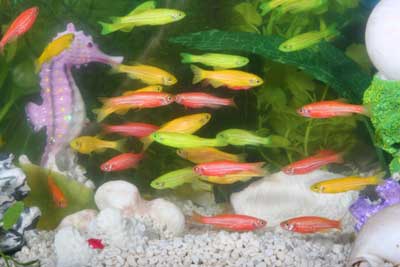
The GloFish was the first genetically modified animal to become available as a pet. It is a natural Zebrafish which has had genetic information from bioluminescent jellyfish added to its DNA. It was originally produced to provide a warning system for pollution but with the addition of further colors its viability for the pet market became clear. It was introduced to the US market in December 2003 by Yorktown Technologies of Austin, Texas.

The grapple is a relatively new fruit which is a genetic cross between an apple and a grape. The fruit combines the size of the apple with the texture of an grape and the flavor of both parent fruits. The grapple was originally designed to provide a much higher vitamin-c dose per fruit for third world aid. The majority of the funding for the fruit came from UNICEF.
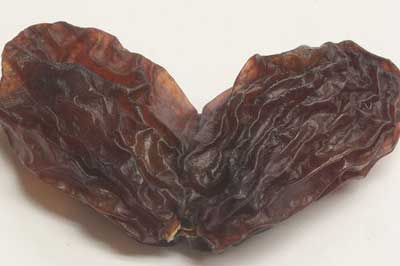
The graisin [giant raisin] is a variety of raisin which has been modified to grow to enormous proportions. The graisin was produced by the National Institute of Genetics in Japan due to the Japanese love of large fruit and the recent popularity of western foods such as raisins. The texture and taste is identical to that of its genetically normal parent and it is served raw or thinly sliced in a stir fry.

Cork trees have long been used for producing cork-stoppers for wine though some wine producers have also begun using plastic corks. Wine enthusiasts have not taken to the rubber corks and so, in order to appease the traditionalists and the cost-cutting wine makers, SABIC innovative plastics have developed a tree which is a cross between a rubber tree and a cork tree. The corks taken from the bark of this new tree look like real cork and have the same porous qualities, but has the permanence and flavorlessness of rubber. Ghislain de Mongolfier, current manager and great grandson of the founder of champagne producer Bollinger, said: “This new cork is the greatest thing to happen to wine since the invention of bubbles”.
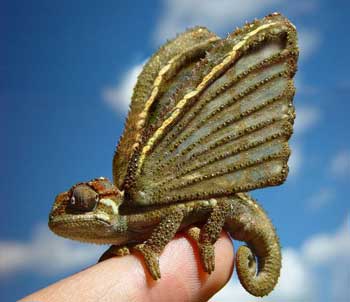
This creature is the only one on the list which was not designed for a practical reason, but merely to prove that it could be done. Genetic Engineers in Zimbabwe (formerly Rhodesia) managed to unlock a dormant “flying” strand in the DNA of the Umbuku lizard, a very small and rare lizard native to Africa. It is believed that the lizard is a descendent of the Pterodactyl, which lost its ability to fly some millions of years ago. To date only 6 of these flying Umbuku have been produced and they are kept seperate from the natural Umbuku due the risk of cross breeding.

The paper tree has been developed to reduce production costs and loss of tree life in the paper manufacturing industry. The recent explosion in popularity of recycled paper products lead a Swiss based company to develop a tree which grows square leaves that, when dried, are already usable as writing paper. In the image above we see a company employee holding a dried leaf beside the trunk of one of the many Paper Trees now grown by the company.
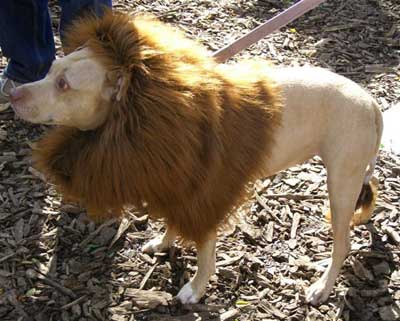
This is probably the most remarkable example of how far science is able to go with modern DNA and cross fertilization techniques; the dolion is a cross between a lion and a dog. In order to produce this incredible rare animal (only 3 dolions exist in laboratories – the photo above is of Rex, the first ever produced), individual strands of DNA from each creature must be combined and re-inserted in to a host egg. This is similar to the liger (lion/tiger crossbreed) with the exception that the liger is able to be produced without prior manipulation of the DNA of either breed of animal.

The Tiny Piney is a miniature pine tree which is a mere 2cm tall when fully grown. It was originally developed to provide a fast growing source for pine-tree smell to be used in the fragrance industry but in very little time its usefulness in other areas became obvious. This tiny pine tree is now hugely popular as an edible plant in Papua New Guinea where it is dipped in a batter made from coconut milk and shellac beetle shells and deep fried. The Tiny Piney (official trademark) has a very subtle pine flavor which is enhanced by the coconut milk. The Tiny Piney is usually eaten as a dessert.
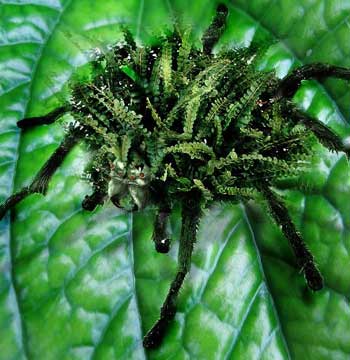
The fern spider is unique on this list as it is the only combined plant and animal. At the time of writing this is the only animal that has successfully been crossed with a plant. The spider is a cross between a common Italian Wolf spider (Lycosa tarantula) and the ponga fern (Cyathea dealbata). The purpose of this bizarre crossbreed was to study the survival rates of spiders with built in camouflage versus those without in a series of studies on Natural Selection at Massey University in New Zealand. The results of the study have not been published yet.
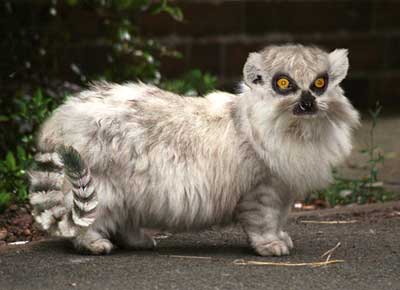
With the growing wealth of China, many rich Chinese women are seeking alternative and exotic pets to show off their money. This has lead to a number of Chinese medical and scientific research companies to compete for this new income source by producing cross breed animals. The most successful (financially) so far has been the Lemur Cat. It is (as the name suggests) a cross between a lemur and a cat. It retains the soft fur of the cat and the coloring, but has the striped tail and yellow eyes commonly found on a lemur. It is more ferocious than the average cat but it is generally no more dangerous than a Chihuahua dog. The scientific name for this new breed is Prolos Fira.








